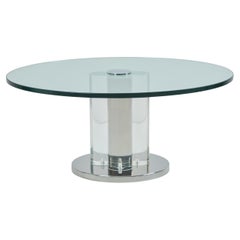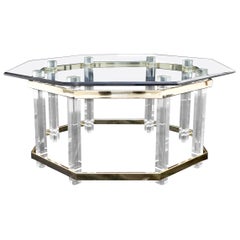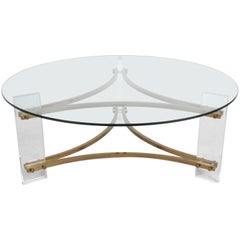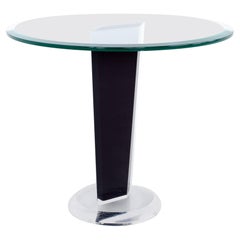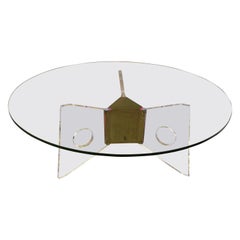Round Lucite And Glass Table
Vintage 1970s American Mid-Century Modern Coffee and Cocktail Tables
Chrome
20th Century American Mid-Century Modern Coffee and Cocktail Tables
Brass
20th Century American Mid-Century Modern Coffee and Cocktail Tables
Brass
Vintage 1970s American Hollywood Regency Coffee and Cocktail Tables
Brass
Late 20th Century American Hollywood Regency Coffee and Cocktail Tables
Glass, Lucite
Mid-20th Century Italian Mid-Century Modern Side Tables
Glass, Lucite
Vintage 1970s American Mid-Century Modern Side Tables
Glass, Lucite
Mid-20th Century Mid-Century Modern Coffee and Cocktail Tables
Glass, Lucite
Mid-20th Century American Mid-Century Modern Coffee and Cocktail Tables
Glass, Lucite
20th Century American Mid-Century Modern Coffee and Cocktail Tables
Glass, Lucite
Late 20th Century Unknown Mid-Century Modern Side Tables
Glass, Lucite
20th Century French Minimalist Tables
Glass, Lucite
Mid-20th Century Unknown Mid-Century Modern Coffee and Cocktail Tables
Brass
20th Century Mid-Century Modern Coffee and Cocktail Tables
Chrome
20th Century Mid-Century Modern Coffee and Cocktail Tables
Chrome
Mid-20th Century Italian Modern Center Tables
Glass, Lucite
Vintage 1970s Mid-Century Modern Coffee and Cocktail Tables
Glass, Lucite
20th Century American Mid-Century Modern Coffee and Cocktail Tables
Chrome
Vintage 1970s American Coffee and Cocktail Tables
Brass
Vintage 1970s American Mid-Century Modern Dining Room Tables
Glass, Acrylic, Lucite
Vintage 1970s American Hollywood Regency Coffee and Cocktail Tables
Chrome
Vintage 1980s American Mid-Century Modern Coffee and Cocktail Tables
Brass
Vintage 1970s American Hollywood Regency Coffee and Cocktail Tables
Glass, Lucite
Vintage 1970s American Mid-Century Modern Coffee and Cocktail Tables
Glass, Lucite
Late 20th Century American Post-Modern Coffee and Cocktail Tables
Glass, Lucite
Vintage 1980s American Mid-Century Modern Coffee and Cocktail Tables
Glass, Acrylic, Lucite
20th Century American Mid-Century Modern Side Tables
Chrome
Vintage 1970s American Hollywood Regency Dining Room Tables
Glass, Lucite
1990s American Post-Modern Nesting Tables and Stacking Tables
Glass, Lucite
20th Century American Mid-Century Modern Gueridon
Glass, Lucite
Mid-20th Century American Mid-Century Modern Side Tables
Glass, Lucite
Mid-20th Century American Mid-Century Modern Coffee and Cocktail Tables
Glass, Lucite
20th Century American Mid-Century Modern End Tables
Chrome
20th Century American Mid-Century Modern End Tables
Vintage 1980s American Post-Modern Side Tables
Brass
Vintage 1970s French Art Deco Carts and Bar Carts
Brass
Vintage 1980s American Modern Coffee and Cocktail Tables
Art Glass, Lucite
Vintage 1970s French Hollywood Regency Coffee and Cocktail Tables
Glass, Lucite
20th Century American Mid-Century Modern Coffee and Cocktail Tables
Brass
20th Century Italian Mid-Century Modern Dining Room Tables
Stainless Steel
Vintage 1980s American Mid-Century Modern Coffee and Cocktail Tables
Glass, Lucite
Late 20th Century American Mid-Century Modern Coffee and Cocktail Tables
Lucite
1990s Belgian Post-Modern Dining Room Tables
Steel, Chrome
Vintage 1970s American Mid-Century Modern Coffee and Cocktail Tables
Brass
Vintage 1970s North American Mid-Century Modern Conference Tables
Brass
Vintage 1970s American Modern Desks and Writing Tables
Steel
Vintage 1970s Italian Post-Modern Coffee and Cocktail Tables
Glass, Plexiglass
Vintage 1960s American Modern Coffee and Cocktail Tables
Steel, Chrome
Vintage 1970s American Mid-Century Modern Coffee and Cocktail Tables
Lucite
20th Century American Mid-Century Modern Dining Room Tables
Lucite
Vintage 1970s American Hollywood Regency Coffee and Cocktail Tables
Glass, Lucite
Mid-20th Century Mid-Century Modern Coffee and Cocktail Tables
Metal
Vintage 1970s Mid-Century Modern Coffee and Cocktail Tables
Glass, Lucite
Late 20th Century Unknown Mid-Century Modern Coffee and Cocktail Tables
Brass
Late 20th Century Italian Hollywood Regency Console Tables
Brass
Vintage 1970s Italian Mid-Century Modern Dining Room Tables
Copper, Chrome
20th Century American Hollywood Regency Barware
Fabric, Plastic, Acrylic, Lucite
20th Century American Mid-Century Modern Dining Room Tables
Aluminum
- 1
Round Lucite And Glass Table For Sale on 1stDibs
How Much is a Round Lucite And Glass Table?
Materials: Plastic Furniture
Arguably the world’s most ubiquitous man-made material, plastic has impacted nearly every industry. In contemporary spaces, new and vintage plastic furniture is quite popular and its use pairs well with a range of design styles.
From the Italian lighting artisans at Fontana Arte to venturesome Scandinavian modernists such as Verner Panton, who created groundbreaking interiors as much as he did seating — see his revolutionary Panton chair — to contemporary multidisciplinary artists like Faye Toogood, furniture designers have been pushing the boundaries of plastic forever.
When The Graduate's Mr. McGuire proclaimed, “There’s a great future in plastics,” it was more than a laugh line. The iconic quote is an allusion both to society’s reliance on and its love affair with plastic. Before the material became an integral part of our lives — used in everything from clothing to storage to beauty and beyond — people relied on earthly elements for manufacturing, a process as time-consuming as it was costly.
Soon after American inventor John Wesley Hyatt created celluloid, which could mimic luxury products like tortoiseshell and ivory, production hit fever pitch, and the floodgates opened for others to explore plastic’s full potential. The material altered the history of design — mid-century modern legends Charles and Ray Eames, Joe Colombo and Eero Saarinen regularly experimented with plastics in the development of tables and chairs, and today plastic furnishings and decorative objects are seen as often indoors as they are outside.
Find vintage plastic lounge chairs, outdoor furniture, lighting and more on 1stDibs.
Finding the Right Tables for You
The right vintage, new or antique tables can help make any space in your home stand out.
Over the years, the variety of tables available to us, as well as our specific needs for said tables, has broadened. Today, with all manner of these must-have furnishings differing in shape, material and style, any dining room table can shine just as brightly as the guests who gather around it.
Remember, when shopping for a dining table, it must fit your dining area, and you need to account for space around the table too — think outside the box, as an oval dining table may work for tighter spaces. Alternatively, if you’ve got the room, a Regency-style dining table can elevate any formal occasion at mealtime.
Innovative furniture makers and designers have also redefined what a table can be. Whether it’s an unconventional Ping-Pong table, a brass side table to display your treasured collectibles or a Louis Vuitton steamer trunk to add an air of nostalgia to your loft, your table can say a lot about you.
The visionary work of French designer Xavier Lavergne, for example, includes tables that draw on the forms of celestial bodies as often as they do aquatic creatures or fossils. Elsewhere, Italian architect Gae Aulenti, who looked to Roman architecture in crafting her stately Jumbo coffee table, created clever glass-topped mobile coffee tables that move on bicycle tires or sculpted wood wheels for Fontana Arte.
Coffee and cocktail tables can serve as a room’s centerpiece with attention-grabbing details and colors. Glass varieties will keep your hardwood flooring and dazzling area rugs on display, while a marble or stone coffee table in a modern interior can showcase your prized art books and decorative objects. A unique vintage desk or writing table can bring sophistication and even a bit of spice to your work life.
No matter your desired form or function, a quality table for your living space is a sound investment. On 1stDibs, browse a collection of vintage, new and antique bedside tables, mid-century end tables and more .
Read More
20 Inviting Dining Rooms Perfectly Arranged for Entertaining
Top interior designers show — and tell — us how to create delectable spaces for hosting dinner parties.
This Alain Delon–Designed Table Is Almost as Handsome as He Was
Fans of the French film star may be surprised to learn that he had a flair for furniture with sleek lines and disco-era flash.
Uchronia’s Plant Stand Gives Pots a Pretty Perch with All the Trimmings
Like other pieces in the firm’s Candy Box collection, the cheerful limited-edition design showcases French craft.
The Ultimate Guide to Types of Tables for the Home
Whether you’re just moving in or ready to give your home a makeover, our guide will give you pointers on tables that are fitting for every room, nook and hallway.
Is Lionel Jadot the Willy Wonka of Upcycled Belgian Design?
From his massive collaborative workshop in a former paper factory, the designer concocts funky furniture from disused materials, as well as luxe hotel interiors like the new Mix Brussels.
Inspired by the Cosmos, Sandra Nunnerley’s Nova Table Has a Futuristic Feel
The designer’s innovative use of an unexpected material gives this console a lift.
This 19th-Century Gilded Desk Displays a Fanciful Kingdom in Marquetry
The stately piece brings both gravitas and whimsy to any work space.
In Guadalajara, These Luscious Side Tables Are Chiseled from Volcanic Rock
Use them as tables or stools, indoors or out.
